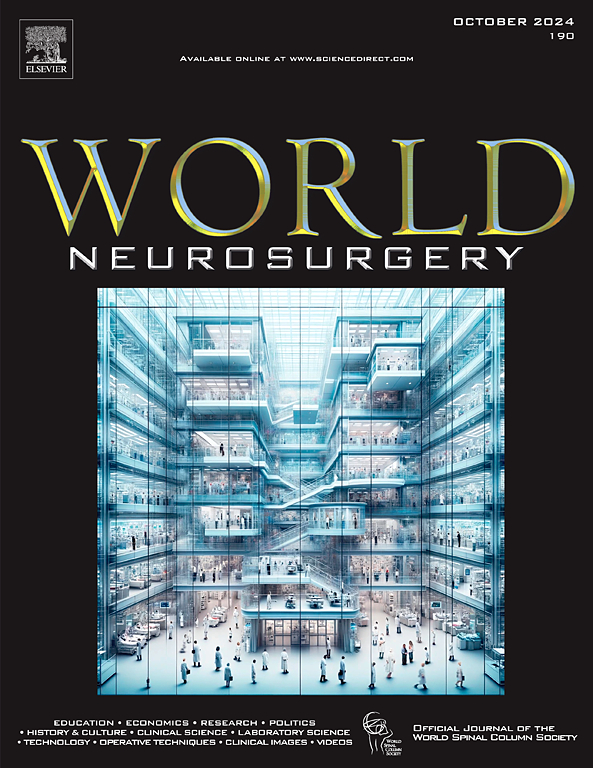经椎间孔全腔镜脊柱手术外入法鸭嘴状松解技术:技术说明。
IF 1.9
4区 医学
Q3 CLINICAL NEUROLOGY
引用次数: 0
摘要
简介在经腔镜全内窥镜脊柱手术(FESS-TF)中,外入式方法有助于治疗各种病例,但该技术难以操作。为了方便这种手术,我们开发了一种鸭嘴松解技术。本文旨在介绍该技术的细节并研究其有效性:将 50 名接受 FESS-TF 治疗的椎间盘突出症患者分为两组:传统技术组和鸭嘴松解技术组。测量两组患者从开始手术到上关节突外骨质暴露的时间。在临床结果方面,比较了手术前后腿部疼痛的视觉模拟量表(VAS)评分和日本骨科协会(JOA)评分:两组患者的背景无明显差异。传统组的手术时间为 252 ± 86 秒,而鸭嘴松解组的手术时间为 105 ± 26 秒,明显缩短(P < 0.001)。在临床结果方面,两组在腿部疼痛 VAS 评分或 JOA 评分的所有终点方面均无明显差异:结论:在 FESS-TF 手术中,外入法鸭嘴松解技术是一种简单省时的高效方法。本文章由计算机程序翻译,如有差异,请以英文原文为准。
Duckbill Release Technique for the Outside-in Method in Full-Endoscopic Spine Surgery via Transforaminal Approach: A Technical Note
Background
In full-endoscopic spine surgery via transforaminal approach (FESS-TF), the outside-in method facilitates treatment for various cases; however, the technique is difficult to perform. To facilitate this procedure, we developed a duckbill release technique. In this article, we aimed to introduce the details of this technique and investigate its effectiveness.
Methods
Fifty patients who underwent FESS-TF for intervertebral disc herniation were divided into 2 groups: the conventional technique and the duckbill release technique groups. The time from the initiation of surgery to exposure of the bone outside the superior articular process was measured in both groups. The visual analog scale score for leg pain and the Japanese Orthopaedic Association score before and after surgery were compared in terms of clinical outcomes.
Results
No significant differences were observed between the 2 groups in terms of patient background. The approach time was 252 ± 86 seconds in the conventional group, while it was 105 ± 26 seconds in the duckbill release group, which was significantly shorter (P < 0.001). In terms of clinical outcomes, the 2 groups did not significantly differ in all endpoints of the visual analog scale score for leg pain or the Japanese Orthopaedic Association score.
Conclusions
The duckbill release technique for the outside-in method in FESS-TF could be efficient because it is a simple and time-saving approach.
求助全文
通过发布文献求助,成功后即可免费获取论文全文。
去求助
来源期刊

World neurosurgery
CLINICAL NEUROLOGY-SURGERY
CiteScore
3.90
自引率
15.00%
发文量
1765
审稿时长
47 days
期刊介绍:
World Neurosurgery has an open access mirror journal World Neurosurgery: X, sharing the same aims and scope, editorial team, submission system and rigorous peer review.
The journal''s mission is to:
-To provide a first-class international forum and a 2-way conduit for dialogue that is relevant to neurosurgeons and providers who care for neurosurgery patients. The categories of the exchanged information include clinical and basic science, as well as global information that provide social, political, educational, economic, cultural or societal insights and knowledge that are of significance and relevance to worldwide neurosurgery patient care.
-To act as a primary intellectual catalyst for the stimulation of creativity, the creation of new knowledge, and the enhancement of quality neurosurgical care worldwide.
-To provide a forum for communication that enriches the lives of all neurosurgeons and their colleagues; and, in so doing, enriches the lives of their patients.
Topics to be addressed in World Neurosurgery include: EDUCATION, ECONOMICS, RESEARCH, POLITICS, HISTORY, CULTURE, CLINICAL SCIENCE, LABORATORY SCIENCE, TECHNOLOGY, OPERATIVE TECHNIQUES, CLINICAL IMAGES, VIDEOS
 求助内容:
求助内容: 应助结果提醒方式:
应助结果提醒方式:


